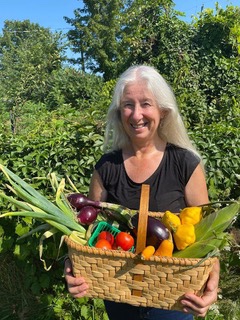Tip of the Week: Sustainable Local Food Lunches
– by Allison Andrews for Sustainable Orillia
I would like to be able to tell you that I only sent my children to school with fabulous, healthy lunches they loved. (And yes, I was still making their lunch when they were in their teens!) But alas, the truth of the matter is that there was a huge divide between what my picky eaters would consume and what I deemed, at the time, to be healthy.
Fast forward several years. I now have three children in their 20’s who are all amazing eaters and excellent cooks. So for those of you who, like me, were worried that their children would not grow “big and strong,” take heart. The answer to healthy eating did not lie in finding the biggest box of organic granola bars, the low fat cookies or the whole wheat bagels. We found it at the markets, at the farms and at the garden plots of the growers and ranchers that have become our friends and heroes.
While this may sound a tad dramatic, it was true for us. As of 2006 my husband and I started taking our children with us to shop for food at the farmers’ markets every Saturday year round, and we quickly moved away from processed foods and most grocery store offerings. Every season brought new local foods, and our children learned when to eat it at its freshest and how to prepare it from frozen during the winter months. Engaging our children in what we considered to be “the real food revolution” helped us as a family to prepare food we all loved.

So, back to school lunches. You know your children better than I do and chances are no amount of lists of healthy snack and lunch ideas is going to satisfy your needs or theirs. My advice, quite simply, is to buy what is fresh, and—as a family—to seek out growers who are at the farmers’ and fresh food markets or who offer Community Supported Agriculture (CSA) boxes. Enquire about farms that allow you to come and pick your own berries or beans or peas or tomatoes. You could even join our community garden in Orillia or grow some of your own vegetables at home. Yes, it takes more time and yes, you will need to do more food preparation and perhaps consider buying another small freezer. However, as your children start to make personal connections with those who are growing their food and when they help to prepare it at home, they will be far more apt to eat it.
Then it goes into their lunch pails. With the exception of milk, you can find cheeses, eggs, fresh breads, leafy greens and vegetables, tubers, fruits, fresh and cured meats, and a myriad of other foods at the market stands or farm gates. The fresh produce can be cooked or eaten fresh. In the spring and fall it can be sliced or cubed and made into stews and soups for the winter months and sent to school in separate glass or metal containers. We made a habit of storing onions, potatoes, carrots and cabbages in the coolest spot in the house and buying extra peppers, eggplants, celery, tomatoes and even mushrooms in the fall to cut up and freeze for sauces, stews and chilis in the winter. If we had a roast chicken one night, our children knew they would be helping to make chicken soup from the stock and garden vegetables the next day after school!
The added bonus to all of this was hope. The farmers and growers that we supported gave us not only wonderful, organically grown food, but also hope that our community would continue to sustain us and others in the future. We just had to show up every Saturday to be a part of it.
This has been a very roundabout way of telling you how to make school lunches that your children will love, but it is the only way that we were able to make it happen. Your children just need to learn to care about where their food comes from—and until they are old enough to have learned that lesson, you need to care about it for them.
